August 19, 2016 report
A new way to make synthetic mother-of-pearl

A team of researchers from several institutions in China and Germany has found a way to create a synthetic type of nacre—more commonly known as mother-of-pearl. In their paper published in the journal Science, the team describes how they sought to emulate the way nacre is produced in nature and in so doing came up with a method that allows for the creation of a material that is very similar to the linings found inside of some mollusks.
Nacre is valuable for two reasons; the first is because it is pretty—oftentimes it looks like a colorful painting technique; it is also the material that gives pearls their unique coloring patterns. The second reason is because nacre is also very strong and crack resistant which makes it useful in a variety of industrial applications. In this latest effort to create the material from scratch the researchers developed a process that very closely mimics how it is done naturally.
In nature, nacre is a material made of tiny aragonite slabs held together by a fibrous gel—similar in structure to fish scales. To make their own version, the team created a subdivided container into which they poured a chitosan solution. The container with the fluid in it was then frozen and then vacuum dried. The mixture was then allowed to mineralize over the course of a few weeks—each section in the container formed into an individual plate of synthetic nacre. The result was not colorful like mother-of-pearl though, because the plates were thicker, but they very much resembled the real material. Close inspection of the faux nacre revealed that the plates were larger than those made naturally which at times caused some to pop out of place, which of course made the material less resistant to cracking. But the development of the technique has shown a new way to make the material, the team reports, and suggests that it might be used as part of a 3-D printing process. Though it is not likely that such materials will be used to make jewelry anytime soon, it does appear possible that some will very soon be used to make new kinds of strong composites.
More information: L.-B. Mao et al. Synthetic nacre by predesigned matrix-directed mineralization, Science (2016). DOI: 10.1126/science.aaf8991
Journal information: Science
© 2016 Phys.org





















